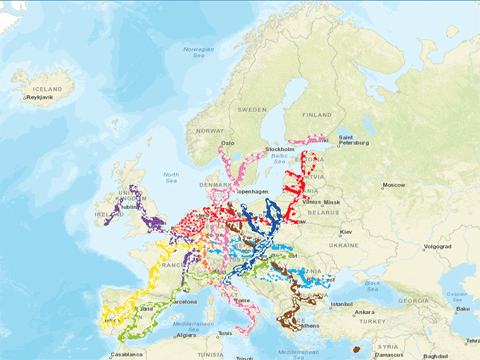Along with the Investment Plan for Europe, the Connecting Europe Facility plays a major role in bridging the investment gap in Europe, one of the Commission's top priorities. The European Commission is firmly delivering on President Juncker's top priority of creating jobs and boosting growth in the European Union, by unveiling a list of 195 transport projects that will receive €6.7 billion of funding under the Connecting Europe Facility (CEF). This investment is expected to unlock additiona
Commission injects €6.7 billion in transport infrastructure to boost jobs and growth
- 17 June 2016

Along with the Investment Plan for Europe, the Connecting Europe Facility plays a major role in bridging the investment gap in Europe, one of the Commission's top priorities.
The European Commission is firmly delivering on President Juncker's top priority of creating jobs and boosting growth in the European Union, by unveiling a list of 195 transport projects that will receive €6.7 billion of funding under the Connecting Europe Facility (CEF). This investment is expected to unlock additional public and private co-financing for a combined amount of €9.6 billion. The selected projects will notably contribute to the digitalisation and decarbonisation of transport, in line with the broader political agenda of this Commission. The Member States eligible for the Cohesion Fund[1] received almost 85% of the funding, which will help bridging the infrastructure disparities across the EU.
Selected projects are primarily located on the core trans-European transport network (TEN-T). Among the beneficiaries are flagship initiatives such as the rehabilitation of the Brasov Sighisoara rail section in Romania, the railway connection Aveiro Vilar Formoso in Portugal, the development of standard gauge railway line in the Rail Baltic corridor, the implementation of the SESAR Deployment Programme and the modernisation of railway line E30 (Zabrze – Katowice – Krakow section) in Poland.
Launched in November 2015, the second CEF calls for proposals generated 406 eligible project proposals. With €12.49 billion of requested EU funding, the calls were widely oversubscribed. This allowed the Commission to select the projects with the highest European added value, while guaranteeing a balanced distribution geographically and between the transport modes. €5.6 billion has been earmarked for Member States eligible for the Cohesion Fund. The contribution to other Commission priority actions, such as the Energy Union or the Digital Single Market, was also evaluated during the selection process.
The EU's financial contribution is made in the form of grants, the co-financing rate of which is between 20% and 50% of the eligible costs of a given project, depending on its type. As regards projects submitted under the Cohesion call, the maximum co-funding rates can go up to 85% of the eligible costs.
Why do we need investment in transport infrastructure?
Transport faces a wide range of financing challenges across the EU: underinvestment, lack of suitable financing solutions, ageing infrastructure, insufficiently developed and non-transparent pipelines of transport projects, continuous growth of urban population, and regulatory and administrative barriers. The European Commission's Investment Plan can help address these issues, paving the way for the competitive and sustainable EU transport system of tomorrow.
The European Fund for Strategic Investments (EFSI) - the heart of the Investment Plan for Europe - aims to overcome current market failures by addressing market gaps and mobilising private investment. By investing in transport infrastructure, equipment, services and research, the EFSI is contributing to stimulating growth and competitiveness. Combining EFSI support with other EU funds is a key part of the overall commitment of the Commission to ensure EU funds are used better across all policy areas.
What are the opportunities for EU funding in the transport sector?
EFSI support can be combined with EU grants from the Connecting Europe Facility (CEF), Horizon 2020 as well as from those EU funds implemented by Member States’ authorities under shared management, namely the European Structural and Investment (ESI) Funds.
- The Connecting Europe Facility has a grant budget of EUR 24.05 billion for TEN-T projects for the 2014-2020 period and the CEF Debt Instrument offers loans and guarantees through the European Investment Bank. The majority of the funding under the CEF will be delivered in the form of grants allocated following competitive calls for proposals.
- The HORIZON 2020 budget includes EUR 6.3 million for smart, green and integrated transport for the 2014-2020 period.
- The European Structural and Investment (ESI) funds foresee a total of approximately EUR 70 billion for the 2014-2020 period: EUR 35.6 billion for transport under the Cohesion Fund and EUR 34.5 billion for transport under the European Regional Development Fund. EFSI provides risk financing instruments. The EFSI and the ESI Funds are complementary and can be used together to mobilise further investment. The Commission issued explanatory guidelines on how to combine these Funds.
Next steps
The proposed funding decision must now be formally approved by the Connecting Europe Facility Coordination Committee, which will meet on 8 July 2016. Adoption of the decision by the Commission is expected for end July 2016. The individual grant agreements will then be prepared by the Innovation and Networks Executive Agency (INEA) and signed with the project beneficiaries in the second half of 2016.
For more information
- Press Release
- ESI Funds Open Data Platform: Network Infrastructure in Transport and Energy
- Contribution of ESI Funds to the Commission's priorities: The Internal Market
- Ex post evaluation of Cohesion Policy 2007-2013: Transport
- Country Factsheets
- Frequently Asked Questions: Second call of the CEF
- MEMO on Transport Investment
- Connecting Europe Facility
- INEA
